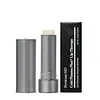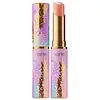What's inside
What's inside
 Key Ingredients
Key Ingredients

 Benefits
Benefits

 Concerns
Concerns

 Ingredients Side-by-side
Ingredients Side-by-side

Cocos Nucifera Oil
MaskingBeeswax
Emulsion StabilisingSimmondsia Chinensis Seed Oil
EmollientRicinus Communis Seed Oil
MaskingHelianthus Annuus Seed Oil
EmollientPolyethylene
AbrasivePolyhydroxystearic Acid
EmulsifyingAcrylates Copolymer
Ethylhexyl Palmitate
EmollientVanillin
MaskingArgania Spinosa Kernel Oil
EmollientAstrocaryum Murumuru Seed Butter
EmollientButyrospermum Parkii Butter
Skin ConditioningOryza Sativa Bran Extract
Skin Conditioning1,2-Hexanediol
Skin ConditioningCaprylyl Glycol
EmollientPhosphatidylcholine
EmulsifyingTocopherol
AntioxidantGlycine Soja Oil
EmollientTribehenin
EmollientRosmarinus Officinalis Leaf Extract
AntimicrobialOctyldodecanol
EmollientSorbitan Isostearate
EmulsifyingHelianthus Annuus Extract
EmollientSilica Dimethyl Silylate
EmollientQuaternium-90 Bentonite
Butylene Glycol
HumectantPentylene Glycol
Skin ConditioningLactic Acid
BufferingMethyl Nicotinate
SoothingPropylene Carbonate
SolventSodium Hyaluronate
HumectantPalmitoyl Tripeptide-1
Skin ConditioningCaffeine
Skin ConditioningNiacin
SmoothingAscorbyl Palmitate
AntioxidantCitric Acid
BufferingCocos Nucifera Oil, Beeswax, Simmondsia Chinensis Seed Oil, Ricinus Communis Seed Oil, Helianthus Annuus Seed Oil, Polyethylene, Polyhydroxystearic Acid, Acrylates Copolymer, Ethylhexyl Palmitate, Vanillin, Argania Spinosa Kernel Oil, Astrocaryum Murumuru Seed Butter, Butyrospermum Parkii Butter, Oryza Sativa Bran Extract, 1,2-Hexanediol, Caprylyl Glycol, Phosphatidylcholine, Tocopherol, Glycine Soja Oil, Tribehenin, Rosmarinus Officinalis Leaf Extract, Octyldodecanol, Sorbitan Isostearate, Helianthus Annuus Extract, Silica Dimethyl Silylate, Quaternium-90 Bentonite, Butylene Glycol, Pentylene Glycol, Lactic Acid, Methyl Nicotinate, Propylene Carbonate, Sodium Hyaluronate, Palmitoyl Tripeptide-1, Caffeine, Niacin, Ascorbyl Palmitate, Citric Acid
Polybutene
Simmondsia Chinensis Seed Oil
EmollientPunica Granatum Sterols
Skin ConditioningDiisostearyl Malate
EmollientPolyethylene
AbrasiveC12-15 Alkyl Lactate
EmollientOctyldodecanol
EmollientIsostearyl Hydroxystearate
EmollientTriisostearyl Citrate
EmollientTrimethylolpropane Triisostearate
EmollientCandelilla Cera
EmollientTridecyl Trimellitate
EmollientEthylhexyl Palmitate
EmollientHydrogenated Polycyclopentadiene
Mentha Piperita Oil
MaskingPhenoxyethanol
PreservativeTribehenin
EmollientTetrahexyldecyl Ascorbate
AntioxidantTocopheryl Acetate
AntioxidantSorbitan Isostearate
EmulsifyingSilica Dimethyl Silylate
EmollientAstrocaryum Murumuru Seed Butter
EmollientTheobroma Grandiflorum Seed Butter
Skin ConditioningCocos Nucifera Oil
MaskingButylene Glycol
HumectantSodium Hyaluronate
HumectantAlgae Extract
EmollientLimonene
PerfumingLinalool
PerfumingGardenia Taitensis Flower Extract
Skin ConditioningTocopherol
AntioxidantPalmitoyl Tripeptide-1
Skin ConditioningCI 15850
Cosmetic ColorantCI 77891
Cosmetic ColorantCI 77491
Cosmetic ColorantPolybutene, Simmondsia Chinensis Seed Oil, Punica Granatum Sterols, Diisostearyl Malate, Polyethylene, C12-15 Alkyl Lactate, Octyldodecanol, Isostearyl Hydroxystearate, Triisostearyl Citrate, Trimethylolpropane Triisostearate, Candelilla Cera, Tridecyl Trimellitate, Ethylhexyl Palmitate, Hydrogenated Polycyclopentadiene, Mentha Piperita Oil, Phenoxyethanol, Tribehenin, Tetrahexyldecyl Ascorbate, Tocopheryl Acetate, Sorbitan Isostearate, Silica Dimethyl Silylate, Astrocaryum Murumuru Seed Butter, Theobroma Grandiflorum Seed Butter, Cocos Nucifera Oil, Butylene Glycol, Sodium Hyaluronate, Algae Extract, Limonene, Linalool, Gardenia Taitensis Flower Extract, Tocopherol, Palmitoyl Tripeptide-1, CI 15850, CI 77891, CI 77491
Ingredients Explained
These ingredients are found in both products.
Ingredients higher up in an ingredient list are typically present in a larger amount.
Astrocaryum Murumuru Seed Butter isn't fungal acne safe.
Butylene Glycol (or BG) is used within cosmetic products for a few different reasons:
Overall, Butylene Glycol is a safe and well-rounded ingredient that works well with other ingredients.
Though this ingredient works well with most skin types, some people with sensitive skin may experience a reaction such as allergic rashes, closed comedones, or itchiness.
Learn more about Butylene GlycolCocos Nucifera Oil is obtained from the kernels of the coconut fruit. In other words, this is coconut oil.
Coconut Oil is rich in fatty acids with lauric acid making up the majority of these. It also contains linoleic acid. Due to this high fatty acid content, coconut oil helps trap moisture and soften skin.
Despite being antibacterial, coconut oil may not be great for acne-prone skin. It is comedogenic and may clog pores. This ingredient may not be safe for malassezia or fungal acne.
Note: Coconut Oil should not replace your sunscreen for UV protection. Studies show it only blocks about 20% of UV.
This oil is non-volatile and has a light scent.
The term 'fragrance' is not regulated in many countries. In many cases, it is up to the brand to define this term. For instance, many brands choose to label themselves as "fragrance-free" because they are not using synthetic fragrances. However, their products may still contain ingredients such as essential oils that are considered a fragrance.
Learn more about Cocos Nucifera OilEthylhexyl Palmitate, also known as octyl palmitate, is created from 2-ethylhexyl alcohol and palmitic acid. It is a fatty acid ester.
The fatty acid content of Ethylhexyl Palmitate makes it an emollient. Emollients help soften and hydrate your skin by trapping moisture within.
Ethylhexyl Palmitate is also used to help improve the texture of cosmetics. It helps other ingredient dissolve in products and help disperse ingredients more evenly.
You'll likely find this ingredient in sunscreen, as it is often used to mix UV-blocking ingredients such as avobenzone and ethylhexyl triazone.
It can also help stabilize the fragrances in a product as a fragrance fixative.
Ethylhexyl Palmitate can be used to substitute mineral oil.
Due to its high fatty acid content, it may not be fungal-acne safe.
Learn more about Ethylhexyl PalmitateOctyldodecanol is a fatty alcohol. It is primarily used to enhance the texture of products.
As an emulsifier, Octyldodecanol helps prevent the oils and waters from separating. It also prevents ingredients from creating foam when shaken.
Octyldodecanol is created by reducing fatty acid to an alcohol.
Due to its high molecular weight, it does not get absorbed into the skin.
Learn more about OctyldodecanolPalmitoyl Tripeptide-1 is also known as pal-GHK. It is made up of 3 amino acids and palmitic acid, a fatty acid that helps it absorb into skin more easily.
This peptide is as a signal peptide, meaning it tells the skin to produce more collagen. Collagen is the key protein that helps form the skin's structure and keep it plump, firm, and hydrated.
By boosting collagen production, this ingredient supports a stronger skin barrier and helps reduce the appearance of wrinkles.
You'll most likely see this ingredient paired with Palmitoyl Tetrapeptide-7 in the well-known Matrixyl 3000 complex. While results from in-house testing should be viewed cautiously, this peptide duo is among the most studied and widely used in modern skincare.
Due to its palmitic acid base, this ingredient may not be safe for Malassezia folliculitis.
Read more about other common types of peptides here:
Learn more about Palmitoyl Tripeptide-1Polyethylene is a synthetic ingredient that helps the skin retain moisture. It is a polymer.
It is also typically used within product formulations to help bind solid ingredients together and thicken oil-based ingredients. When added to balms and emulsions, it helps increase the melting point temperature.
This silica is mainly used to thicken oils and suspend particles in oils. It is not water soluble.
According to the manufacturer, it:
The manufacturer also claims this ingredient to be useful in makeup.
In lipstick formulations, this ingredient improves color payoff, reduces pigment settling, and reduces oil bleeding. This ingredient also improves the grip of powder products such as dry shampoos.
Learn more about Silica Dimethyl SilylateThis oil comes from the seeds of the desert shrub called Jojoba. It is more commonly known as jojoba oil, a non-comedogenic oil.
Jojoba oil does not contain fragrance and has many fatty-acids, making it a great soothing ingredient.
It also contains Vitamin E, a great moisturizing ingredient. Vitamin E is also an antioxidant and protects your skin against oxidative damage.
This ingredient humectant properties, meaning it helps draw moisture from the air. This helps keep your skin hydrated.
While jojoba has antibacterial properties, it is only able to kill some strains of bacteria.
Studies also show it helps in wound healing. In fact, Indigenous cultures have used jojoba as a moisturizer and to help treat burns for centuries.
Fun fact: Jojoba oil similar to natural human skin sebum, so it has a great effect on dry skin. It is also promising with helping to regulate sebum production.
Due to its fatty acid content, Jojoba oil may not be fungal acne safe. We recommend speaking with a professional if you have any concerns.
Learn more about Simmondsia Chinensis Seed OilSodium Hyaluronate is hyaluronic acid's salt form. It is commonly derived from the sodium salt of hyaluronic acid.
Like hyaluronic acid, it is great at holding water and acts as a humectant. This makes it a great skin hydrating ingredient.
Sodium Hyaluronate is naturally occurring in our bodies and is mostly found in eye fluid and joints.
These are some other common types of Hyaluronic Acid:
Learn more about Sodium HyaluronateSorbitan Isostearate is an emulsifer and cleaning agent. It is created from isostearic acid and sorbitol.
As an emulsifier, Sorbitan Isostearate prevents oils and water from separating.
Due to its isostearic acid base, it may not be safe for Malassezia or fungal acne.
Learn more about Sorbitan IsostearateTocopherol (also known as Vitamin E) is a common antioxidant used to help protect the skin from free-radicals and strengthen the skin barrier. It's also fat soluble - this means our skin is great at absorbing it.
Vitamin E also helps keep your natural skin lipids healthy. Your lipid skin barrier naturally consists of lipids, ceramides, and fatty acids. Vitamin E offers extra protection for your skin’s lipid barrier, keeping your skin healthy and nourished.
Another benefit is a bit of UV protection. Vitamin E helps reduce the damage caused by UVB rays. (It should not replace your sunscreen). Combining it with Vitamin C can decrease sunburned cells and hyperpigmentation after UV exposure.
You might have noticed Vitamin E + C often paired together. This is because it is great at stabilizing Vitamin C. Using the two together helps increase the effectiveness of both ingredients.
There are often claims that Vitamin E can reduce/prevent scarring, but these claims haven't been confirmed by scientific research.
Learn more about TocopherolTribehenin comes from glycerin and behenic acid.
It is used as an emollient, or moisturizer. Emollients form a thin barrier on skin to prevent moisture from escaping.
This ingredient may not be Malassezia folliculitis, or fungal-acne safe.
Learn more about Tribehenin